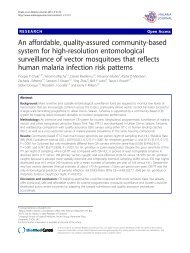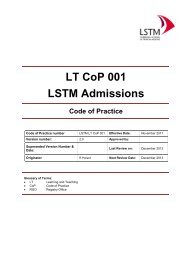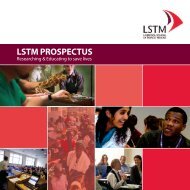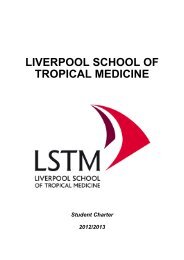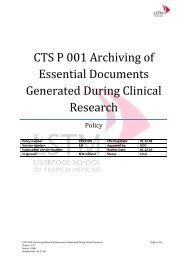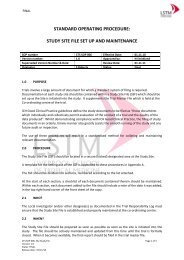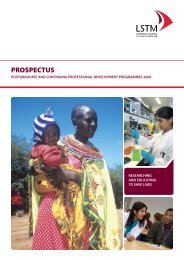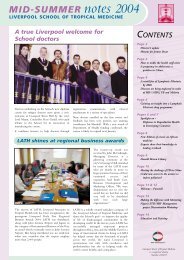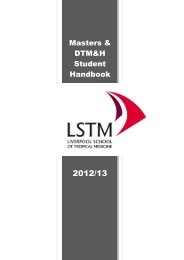Gender influences on child survival, health and nutrition: a ... - Unicef
Gender influences on child survival, health and nutrition: a ... - Unicef
Gender influences on child survival, health and nutrition: a ... - Unicef
You also want an ePaper? Increase the reach of your titles
YUMPU automatically turns print PDFs into web optimized ePapers that Google loves.
<str<strong>on</strong>g>Gender</str<strong>on</strong>g> Influences On Child Survival, Health And Nutriti<strong>on</strong>: A Narrative Review<br />
schemes differ widely as to their gender-awareness <strong>and</strong> sensitivity. When such schemes have been<br />
evaluated from a gender perspective there have been some interesting findings: for example in India<br />
evaluati<strong>on</strong>s have found that where the schemes have been more successful, male earners have shifted<br />
financial resp<strong>on</strong>sibilities for the household <strong>on</strong>to women (who generally earn less <strong>and</strong> work less<br />
regularly) while also taking c<strong>on</strong>trol of the extra income (Batliwala & Pittman 2010). Women have also<br />
reported greater levels of violence, where tensi<strong>on</strong>s have arisen in the home due to their improved<br />
ec<strong>on</strong>omic situati<strong>on</strong>, especially where schemes have excluded men (ibid).<br />
A r<strong>and</strong>omised c<strong>on</strong>trol trial carried out in Peru was based <strong>on</strong> the hypothesis that microcredit clients<br />
participating in the <strong>health</strong> educati<strong>on</strong> comp<strong>on</strong>ent of the programme, would gain knowledge of <strong>child</strong><br />
<strong>health</strong> issues which would translate into positive <strong>health</strong> outcomes for their <strong>child</strong>ren (Hamad, Fernald<br />
& Karlan 2011). The interventi<strong>on</strong> being evaluated was an Integrated Management of Child Illness (IMCI)<br />
based <strong>health</strong> educati<strong>on</strong> programme am<strong>on</strong>g clients of a micro-credit scheme in Peru. The authors point<br />
out that the study is “novel in investigating the effect of IMCI in the setting of an ec<strong>on</strong>omic interventi<strong>on</strong>,<br />
in which the potentially increased income <strong>and</strong> empowerment provided by the microcredit may increase<br />
clients’ ability to act <strong>on</strong> the informati<strong>on</strong> gleaned from the educati<strong>on</strong>al sessi<strong>on</strong>s.” (p. 2). They also<br />
hypothesised that the effects would be greater am<strong>on</strong>g women <strong>and</strong> their <strong>child</strong>ren, as female clients have<br />
been previously shown to invest more in their <strong>child</strong>ren than male clients.<br />
While the study found that parents’ knowledge improved following the interventi<strong>on</strong>, <strong>child</strong><br />
anthropometric status remained unchanged. The <strong>on</strong>ly significant difference noted was am<strong>on</strong>g clients<br />
whose loan officer was c<strong>on</strong>sidered more highly skilled in delivering the educati<strong>on</strong> sessi<strong>on</strong>s. In this<br />
category, <strong>child</strong>ren had lower levels of bloody diarrhoea. The study c<strong>on</strong>cludes that factors such as the<br />
relative higher levels of knowledge already present in the client populati<strong>on</strong> <strong>and</strong> the fact that <strong>health</strong><br />
infrastructure had not changed, may explain the lack of positive results. However they do stress the<br />
importance of c<strong>on</strong>ducting further studies in other c<strong>on</strong>texts as microcredit is c<strong>on</strong>sidered to be a<br />
particularly str<strong>on</strong>g method of delivering interventi<strong>on</strong>s, a claim which requires further testing.<br />
A recent review of 20 world-wide cash transfer programmes was recently undertaken focusing <strong>on</strong> the<br />
potential of cash transfers to protect educati<strong>on</strong>, <strong>health</strong> <strong>and</strong> nutriti<strong>on</strong> (Adato & Bassett 2009).The<br />
review looks at 10 c<strong>on</strong>diti<strong>on</strong>al <strong>and</strong> 10 unc<strong>on</strong>diti<strong>on</strong>al programmes. C<strong>on</strong>diti<strong>on</strong>al programmes are those<br />
which place certain restricti<strong>on</strong>s <strong>on</strong> the way cash is disbursed <strong>and</strong> may require attendance by mothers at<br />
clinics or attendance by their <strong>child</strong>ren at school, for example. Although the review does not focus<br />
specifically <strong>on</strong> gender, cash transfer programmes have been developed using a similar rati<strong>on</strong>ale to<br />
micro-credit schemes, with the objective of improving family <strong>health</strong> through directing ec<strong>on</strong>omic<br />
resources to mothers.<br />
The review provides c<strong>on</strong>siderable evidence for both c<strong>on</strong>diti<strong>on</strong>al <strong>and</strong> unc<strong>on</strong>diti<strong>on</strong>al programmes to<br />
improve <strong>health</strong>-seeking behavior for <strong>child</strong>ren, e.g. participati<strong>on</strong> in growth m<strong>on</strong>itoring <strong>and</strong> promoti<strong>on</strong><br />
<strong>and</strong> attendance at prenatal clinics <strong>and</strong> participati<strong>on</strong> in preventative <strong>health</strong>-care visits. These<br />
improvements have been attributed to the fact that cash transfers cover costs directly associated with<br />
accessing <strong>health</strong> care as well as providing incentives for participati<strong>on</strong> in <strong>health</strong> care <strong>and</strong> educati<strong>on</strong>. N<strong>on</strong><br />
c<strong>on</strong>diti<strong>on</strong>al cash transfers were found to be particularly linked to improvements in nutriti<strong>on</strong> which in<br />
turn impacts <strong>on</strong> <strong>health</strong>.<br />
As with micro-credit schemes there are strengths <strong>and</strong> weaknesses to this approach. The review suggests<br />
that overall cash transfer schemes offer the best strategy for providing country-wide social protecti<strong>on</strong><br />
55



